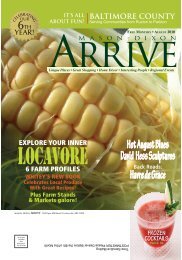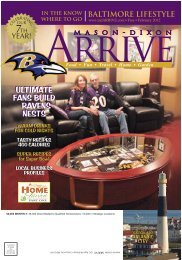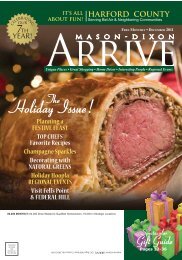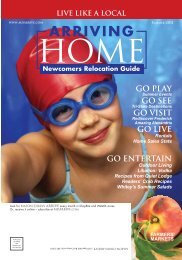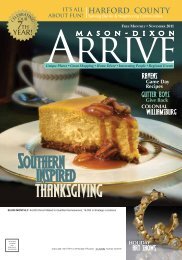baltimore county - Mason Dixon Arrive Magazine
baltimore county - Mason Dixon Arrive Magazine
baltimore county - Mason Dixon Arrive Magazine
You also want an ePaper? Increase the reach of your titles
YUMPU automatically turns print PDFs into web optimized ePapers that Google loves.
antiques<br />
I have always loved Easter collectibles, a fact that is a little bit<br />
surprising because, in my family, we celebrate Passover instead<br />
of Easter.<br />
When I was 8 years old, the Easter holiday fell on the same<br />
week as Passover. I had the time of my life decorating eggs with<br />
my mother and sister, only to discover, just as I was dressing to<br />
attend Passover services at our synagogue, that the dark purple<br />
and pink dyes would not wash off. After scouring and scouring,<br />
to no avail, we all attended services with white cotton gloves on<br />
our hands, a memory that I will never forget. It still makes me<br />
laugh when I think of it.<br />
Easter collectibles cannot help but put a smile on anyone’s<br />
face. There’s something so renewing and joyful about all of the<br />
bunnies, the baby chicks and the baskets of eggs. I don’t know<br />
how the serious holiday of Easter came to be represented by<br />
such non-serious secular symbols, but just seeing them makes<br />
me happy.<br />
There are all sorts of Easter items to collect, from all time<br />
periods. There are wooly sheep with wooden stick legs from<br />
the late 1800s, tin baskets from the turn of the century and<br />
wacky neon-colored plastic eggs from the 1970s. But I think<br />
in my previous life I must have lived in the late 1800s, because<br />
Victorian items are always the things that make me pull out my<br />
pocketbook to add “just one more” to my collections.<br />
One of the most popular items for collectors is a postcard.<br />
Personally, I have hundreds of them. When I can buy an<br />
authentic piece of artwork that is 100 years old, for only a few<br />
dollars, why not buy one more?<br />
Easter postcards from the golden age of postcard collecting,<br />
1898-1918, are plentiful and inexpensive. At the turn of the last<br />
century, collecting postcards in large scrapbooks was a popular<br />
hobby among ladies, sort of like modern day scrapbooking is<br />
today. A hundred years later, these albums are often still intact,<br />
with the cards stored safely inside.<br />
The best quality cards from that time were printed in<br />
Germany. Several American card companies including John<br />
Winsch, The International Art Publishing Company and the<br />
very famous Raphael Tuck & Sons had offices and studios in<br />
America but sent their cards to Germany to be printed and<br />
published. German cards are recognizable for their embossed<br />
cardstocks, hand colored details, depth of design, and metallic<br />
and silk trim. I can always tell if a card is German – even before<br />
I turn it over and look for the country of origin mark.<br />
Postcards are great for holiday decorating. For a very small<br />
investment you can build a collection of Easter postcards and<br />
use them to decorate your mantle and Easter breakfast table.<br />
I always send antique postcards to my friends for the holidays.<br />
One friend has kept all of the cards and displays them<br />
By Linda Sarubin<br />
<br />
Collections for Easter<br />
seasonally in a wire wreath. Not only is it a conversation<br />
starter, it is a way for me to still be present at my friend’s celebrations,<br />
even though we now live very far apart.<br />
Easter celebrations have always included candy. Many years<br />
ago children were given candy in baskets, of course, but also<br />
in delicate and intricately molded figural candy containers.<br />
The containers were made from tin, glass, cardboard or paper<br />
mache. They were made in the shapes of dogs, trains, autos,<br />
boats, lanterns and mailboxes. Easter containers were shaped<br />
like bunnies, chicks and lambs.<br />
I wish I had collected candy containers a decade or so ago,<br />
when prices were more affordable. Now I see them at antiques<br />
shows priced anywhere from $150 apiece to $500 or more.<br />
And unique containers that have unusual themes, such as bunnies<br />
riding in an automobile, or chickens paddling a boat, can<br />
sell for much more.<br />
I understand the high prices. If Victorian children were<br />
Opposite Top: Many postcard collectors look for chicks and bunnies<br />
dressed like people. This German card is desirable, even in less than<br />
perfect condition, because of its amusing subject matter. Opposite Bottom:<br />
Victorians were crazy for crafting, just like we are today. Tiny paper scraps<br />
like these were used to decorate Easter eggs and to make greeting cards.<br />
Left Top: These large candy containers were made in Germany in the late<br />
19th century. The heads of the rabbits are removable to allow access to the<br />
candies hidden inside. Left Second from Top: This wooly lamb pull toy was<br />
a special treat for a very lucky boy or girl at the turn of the last century. Left<br />
Third photo: A Victorian wire egg holder with two lithographed cardboard<br />
eggs. The eggs, made in Germany, open up to hold treats. Left Bottom:<br />
Glass candy containers like these had removable cardboard bottoms. Most<br />
of the major glass companies in America made glass toy novelties along<br />
with their regular lines of stemware and serving bowls.<br />
anything like my four granddaughters<br />
are today, the delicate candy<br />
containers were ripped to shreds<br />
in seconds. Who knew they would<br />
be valued as prized collectibles?<br />
The ones that survived are rare and<br />
expensive. Look for flocking, glass<br />
eyes and paint that has survived the<br />
decades.<br />
Like the postcards I mentioned<br />
earlier, the best candy containers<br />
were made in Germany. German<br />
villages were filled with small family<br />
workshops and large factories whose<br />
sole purpose was cranking out various<br />
holiday goodies to be exported<br />
to America. Expect to pay more<br />
for a German holiday items than<br />
ones that were made in the USA.<br />
Reproductions have been made that<br />
carefully mimic the old candy containers,<br />
so look for items that appear<br />
to have genuine age.<br />
Easter isn’t Easter without eggs.<br />
The egg has always been a universal<br />
symbol of renewal and rebirth – perfect<br />
for Easter celebrations.<br />
Of course the most famous of all<br />
decorated eggs were created between<br />
1884 and 1917 for Czars Alexander<br />
III and Nicholas II by the Russian<br />
jeweler Peter Carl Faberge. These<br />
eggs were encrusted with gold, silver<br />
and gems, and surrounded by brilliantly<br />
colored enamel. There were<br />
more than 100 of these treasures<br />
made, but only 69 still survive today.<br />
Most are in museums, but if they<br />
ever came up for sale, they would<br />
sell for many millions of dollars.<br />
You don’t have to spend millions<br />
to collect eggs though. Antique<br />
shops are filled with all sorts of decorated<br />
eggs for collectors. In the late<br />
Victorian era, milk glass eggs were<br />
embossed, hand painted and gilded.<br />
Large pressed cardboard eggs were<br />
covered with vibrant lithographed<br />
papers depicting images of spring<br />
– children, flowers, chicks and bunnies.<br />
Like many decorative Easter<br />
items, the eggs opened to provide a<br />
hiding place for treats. These candy<br />
container eggs often had a loop of<br />
string on the top so that they could<br />
be hung as ornaments.<br />
In the early 20th century, J.<br />
Chein and other toy companies produced<br />
tin lithographed eggs, often<br />
using the same colorful designs that<br />
they printed on their other tin novelties,<br />
such as sand pails, banks and<br />
children’s dishes.<br />
Easter egg cups are collectibles<br />
that you can use year round. They<br />
were usually made from milk glass<br />
with molded heads of bunnies and<br />
chicks. I love the idea of setting the<br />
Easter table with a different glass<br />
egg cup at each guest’s plate. They<br />
are the perfect size for small candies<br />
and nuts.<br />
Easter collectibles just make<br />
me happy, and it doesn’t hurt that<br />
they are often accompanied by foil<br />
wrapped chocolates and jelly beans!<br />
As we open up our old country<br />
store after being closed for the long<br />
hard winter – and it certainly was a<br />
rough one this year – I am thrilled<br />
to dust off the shelves and decorate<br />
the front windows and counters<br />
with hopping bunnies and chicks in<br />
baskets.<br />
Sarubin, along with her husband,<br />
Carroll Swam, and their poodle,<br />
Noodle, own an antiques store in<br />
southern Pennsylvania, The<br />
Gatchellville Store, 717-382-9252 or<br />
gatchellvillestore@zoominternet.net.<br />
72 <strong>Mason</strong>-<strong>Dixon</strong> ARRIVE | APRIL 2011 <strong>Mason</strong>-<strong>Dixon</strong> ARRIVE | APRIL 2011 73






